I published my first Medium story (that’s what Medium calls articles or posts) on February 24, 2014. Over the nearly ten years since, I’ve learned a lot about the ins and outs of the platform while publishing hundreds of stories and amassing 50k(!) followers.
Medium constantly evolves and expands features, so whether you are a long-time user like me or a brand new user, there’s always something new to discover. This guide collects all the tidbits and tips I’ve picked up along my Medium journey and aims to help you make the most out of your Medium experience.
Everything featured in this guide assumes you have a Medium account. If you’re not signed up yet, create your Medium account (affiliate link) and come back ready to read.
After creating your account, personalize your bio and profile page. Think of your bio as your tagline. This short sentence appears everywhere your profile picture does and gives other Medium users a sense of who you are (and if they should follow you or not). Medium also provides tools to customize the design of your profile. If interested, set the colors, fonts, and graphics just the way you like them.
Ok, now that your account is ready to go, let’s get on with the guide.
Read Stories and Follow Content
At its core, Medium is a great place to read amazing stories — from commentary to nonprofit resources, from laptop reviews to writing advice, from tech journalism to letters from the CEO — everything you’re interested in is found here.
There are two types of stories published on Medium: free and metered.
- Free stories are available to anyone, even those without a Medium account.
- Metered stories are published behind Medium’s paywall, known as the Medium Partner Program. Metered stories have a small star next to the read time and are only available to Medium members who pay a monthly fee. Free users can read three metered stories per month without upgrading to a paid membership.

Writers who publish metered stories receive compensation based on the view-time of paying Medium members. So, if you’re a paying Medium member, the more time you spend reading, the more money a writer makes! It’s the easiest way to show your appreciation for excellent writing (which we’ll dig into later). If you sign up as a paying Medium member using a writer’s affiliate link, they get 50% of your Medium fee — another great way to support your favorite reader.
For example, if you sign up for Medium using my affiliate link, I earn 50% of your fee for as long as you’re a Medium member. You can directly support my writing and unlock access to the entire Medium catalog at the same time. Ready to join Medium? Sign up today (affiliate link)!
On Medium, you find amazing stories to read by following writers, publications, or topics. You can also find new stories by exploring tags.
Writers
Writers are people like me (and maybe even you!) who write and publish stories on Medium. Some writers I enjoy reading are Benjamin Sledge, Zulie Rane, M.G. Siegler, Mark Ellis… the list could go on forever. You should follow any writer that interests you and whose stories you want to read. This ensures their content appears in your feed, particularly on your Medium homepage.
Follow writers by hitting the Follow button next to their name on any story or profile page. You can also hit the ✉️ button to subscribe to that writer’s stories. Every time they publish, you’ll get an email update.
Publications
Publications are collections of published stories. Each publication is run by one or more editors who publish stories based on the publication’s theme. For example, my publication The Writing Cooperative is focused on writing, while Better Humans is focused on self-improvement. On Medium, stories can only appear in a single publication at a time.
Some publications have separate newsletters you can sign up for. These vary by publication, but newsletters are an additional way to keep up with content you’re interested in reading. For example, The Writing Cooperative’s This Week In Writing provides a look at writing every Tuesday.
Tags
Tags are collections of stories that all share a similar theme, regardless of publication. When publishing, writers can choose up to five tags for their stories. The first tag a writer selects is displayed in the Medium feed.
For some tags, Medium identifies the top writers publishing in that niche. Writers earn Top Writers status based on the number of popular stories they publish with the tag.
Muting writers and publications
Love a particular topic but aren’t fond of the content published by a specific writer or publication? You can mute them, and their content will no longer appear in your feed.
Lists
You can save stories into customized lists for reading later or sharing with friends. For example, I have a few lists, including the best of my Write Now interviews and a collection of submission guides for Medium publications.
Lists, indicated by the bookmark icon, provide a great way to save a story for later. The story will remain on your list for as long as you want (unless the author deletes it) and provide offline access to read the content if you’re a paying Medium member.

Connect With People on Medium
While the core of Medium is focused on publishing great stories, it is also a social network built around connecting with other people. Over the years, I’ve met and connected with many amazing writers and creators through the platform. Those connections help me grow as a writer and elevate the quality of everything we collectively publish.
Medium provides easy ways to connect with writers: private notes, highlights, and responses.
Private notes (only available on a desktop browser)
Private notes are direct messages between you and the story’s writer. These are used for quick comments, questions, or editing suggestions. Private notes are only visible to the author and the person who left the note. When a story is published in a publication, the publication’s editors can also see any private notes left on the story. An * indicates a private note in the right-hand margin of a story.
Private notes are intended to be brief. Medium sets a 400-character limit on initial private notes and a 200-character limit on all replies.
To leave a private note, highlight a word or phrase with your cursor and select the lock icon. Because notes are tied to specific words or phrases, private notes are similar to margin notes left between an editor and an author.
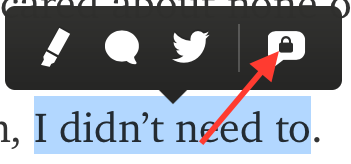
Highlights
Highlights (the first button on the popup pictured above) are a form of response without explanation to the author. You can highlight anything you like. I opt to highlight sentences I agree with or find incredibly well written.
The phrase or sentence highlighted the most, called the top highlight, is visible to everyone. Highlights from people you follow are visible to you. The writer and publication owners see everything highlighted in every story.

Responses
Responses are designed to facilitate a public conversation (think of it as the comment section of a YouTube video, but usually much friendlier). Responses are publicly available. I prefer private notes over responses, but it comes down to personal preference.
At one time, responses created a new Medium story. Now, while that is still an option when composing a response, it is no longer the default.
Should you want to respond to a specific passage, highlight it and click the respond button (it’s the speech bubble icon in the middle of the popup). You can also click the 💬 button at the bottom of each story to leave a general response without quoting a specific phrase.
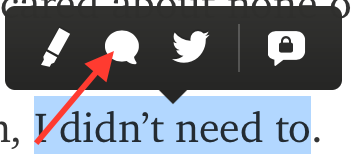
Support Writers
One of the best ways to show appreciation to a writer is by supporting their work. While purchasing their work (like my book) is a great way to support writers financially, Medium provides multiple free ways to support writers: clapping, sharing, following, and reading.
Clap
When you read something you enjoy, click the 👏 icon at the bottom of the story. You can clap for any story up to 50 times. The more claps a story receives, the more likely Medium will feature the story in other readers’ feeds. Clapping helps more people see the story you enjoyed.

Share
Another great way to help promote stories you enjoy is by sharing them on your other social networks. On the browser version of Medium, clicking the share button creates posts for Twitter, Facebook, and LinkedIn. The share button on Medium’s mobile app generates graphics ready for Instagram featuring highlighted text from the story.
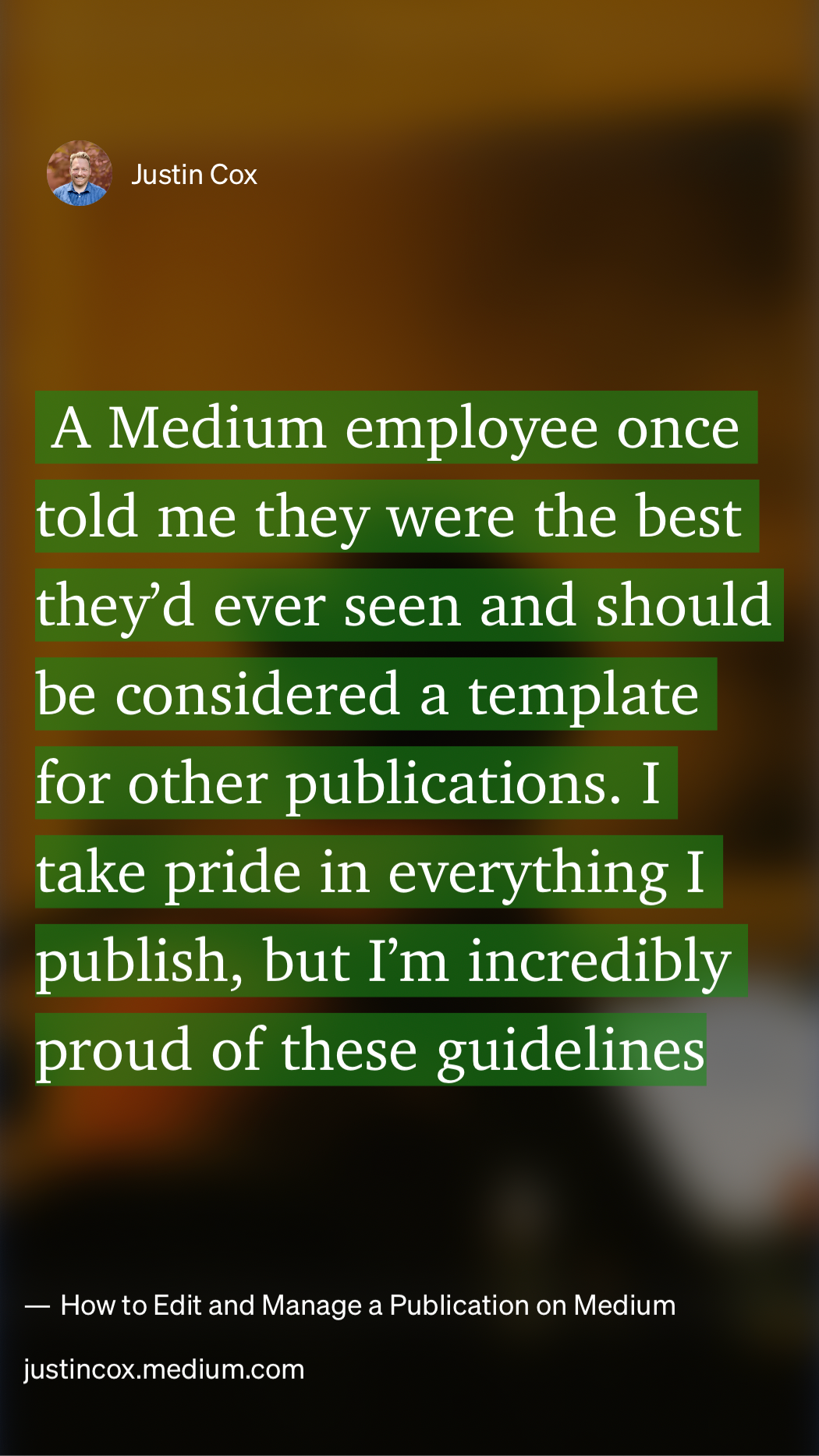
On the browser version of Medium, highlight a sentence you enjoy and click the Twitter icon in the popup. Medium creates a quote-tweet for you to share and leave a highlight of the passage.
If you like something, don’t be afraid to share it with your friends. Not only does it support the writer’s work, but it helps expand their audience as well. Trust me, writers really appreciate this type of support!
Follow
Follow the writer on Medium and off when you read something you particularly enjoy. Medium profiles often contain links to the writer’s Twitter, Facebook, and LinkedIn profiles, providing easy access to the writer elsewhere. Following the writer on and off Medium signals that you enjoy their work. Retweeting or sharing that writer’s content off Medium is also a great way to show appreciation.
Join Medium
When you become a paying Medium member, everything you read compensates the writer. While this form of support isn’t free, you don’t pay anything more than the monthly membership fee. Medium calculates how long you read each story and splits your monthly membership fee with each writer.
Master the Medium Editor
Not only does Medium provide a fantastic platform to read great content, but it’s also a fabulous place to write great content. Writing on Medium allows you to grow an audience of dedicated readers who use all the sharing and connection tools described above to support you! How does that sound?
Medium makes it incredibly easy to write on the platform. To start a new story, click the write button on the lefthand sidebar. Writing or editing stories is once again possible on the mobile app! There, hit the + button or click on your profile and select Drafts.

From well-formatted headlines to SEO tools, Medium’s editor provides several tools to ensure your story looks incredible. Mastering the formatting tools will ensure your story is ready for the audience.
Kickers, Titles, and Subtitles
A new draft on Medium begins with two lines of text: “Title” and “Tell your story…” While you can immediately start writing, Medium provides hidden ways to stylize the title by adding a kicker and subtitle.
- A kicker sits above the title and typically indicates a topic, column title, or category. Kickers are not common but add flair to stories when used appropriately. Create a kicker by putting text above the title and styling with the small T heading format.
- Subtitles are extremely common and recommended for every story. They sit below the title and form when styling text with the small T heading option.

Section Headings
Section headings break up blocks of text. They also provide search engine optimization, which can help your story find life outside Medium. Section headings are best used when they’re short, focused on the content to come, and provide the reader with context.
Medium provides two options for section headings, indicated by a large or small T in the formatting toolbar. These create a hierarchy when combined with the title of the article. Small T section headings should always fall below large T section headings.
For example, this section’s heading is a small T heading because it’s under the big T section heading that reads “Master the Medium Editor.”
To create a section heading, highlight any line of text and select the preferred style.
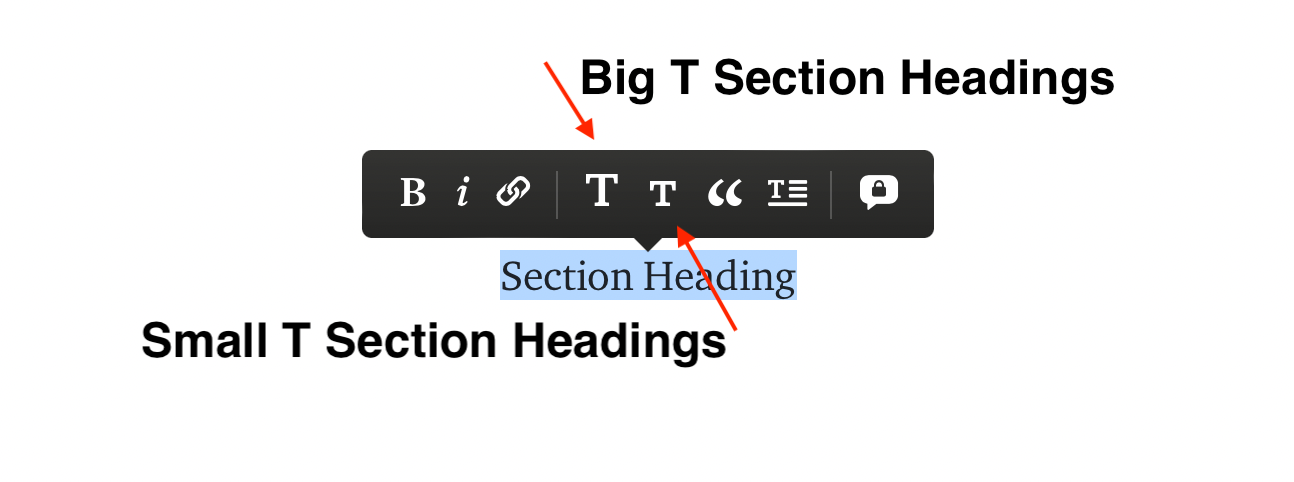
Text Formatting
In addition to section headings, Medium offers all the standard text formatting tools. Bold, italics, and links are selected by highlighting any text and choosing the appropriate icon. Familiar keyboard shortcuts also work to style text.
Blockquotes
The quote button on the editing toolbar offers two formats. Highlighting text and clicking the quote button initially creates a blockquote.
Blockquotes formats a block of text written by someone else to stand out from the text written by the author. Quoting someone else’s article or using a passage from a book are great examples of blockquotes. Some Medium writers use blockquotes as text formatting for their words.
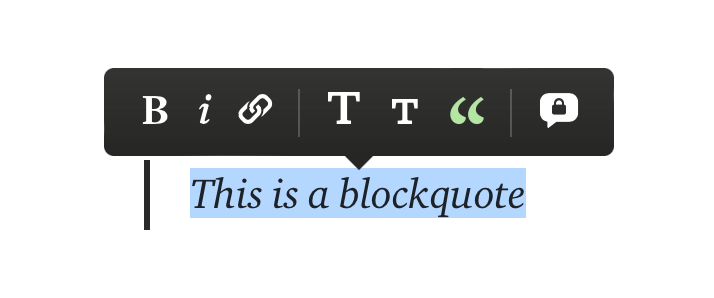
Pull Quotes
Hitting the quote button a second time generates a pull quote.
In typical publishing, pull quotes pull a line or phrase from the article to add style and draw the reader’s attention. That is how they’re used in The Writing Cooperative. Some Medium writers prefer to use pull quotes as a form of formatting.
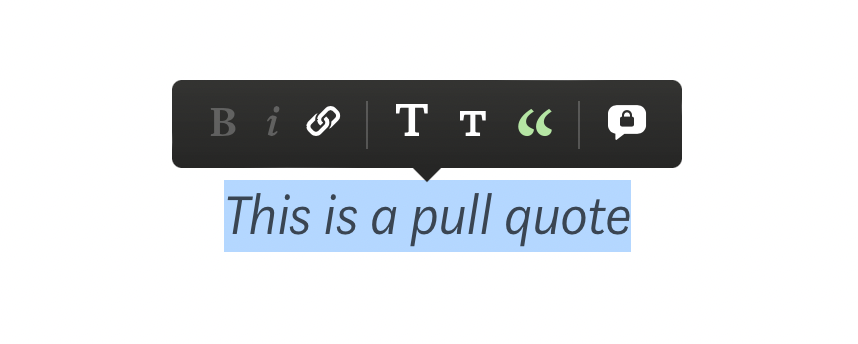
Drop Caps
Want to add style to the beginning of your story? A drop cap might do the trick. In typical publishing, drop caps, like the W at the start of this paragraph, and begin a chapter or significant section to add emphasis and style. While they are not common on Medium, they can add a bit of flair when used appropriately.
Medium provides a hidden way to upgrade your drop caps. Create a graphic of the letter you want to use, click on your drop cap letter to highlight it, then drag the letter graphic into the highlighted square. That’s how I managed to create the red W at the start of this section.
Images
Every story needs at least one high-quality featured image. The featured image helps your story stand out in Medium’s feed and is used when the story is shared on social channels. Thankfully, Medium’s desktop editor makes finding a great image easy.
Start a new line, click the + button to the cursor’s left, and select the magnifying glass. This searches the entire Unsplashlibrary to find the perfect image. Plus, Medium adds the image to the story with proper attribution to the photographer. It’s easy and courteous!

When using Unsplash, consider creative search terms to find unique pictures. As a publication editor, I often see the same images all over Medium. Not only is this repetitive, but it doesn’t help your story stand out in a crowd.
There are other copyright-free image options if you don’t want to use the built-in Unsplash tool. Some popular image options include Pexels, Mixkit, WikiCommons, and searching photos with Creative Commons Licenses on Flickr.
Regardless of what tool you use to find a featured image, it’s important only to include photos you have the right to republish. Not every image found online is available for use in your story. Be sure to understand image usage rights and correctly cite all images when publishing on Medium.
After placing an image into your story, click on it, and you have a few options.
- Click the Alt text button to set descriptive text for people using screen readers.
- Add a caption to the bottom of the photo, typically used to display usage rights and photo credit.
- Set the focal point so Medium knows where to crop when displaying image previews in the feed. Do this by
option-clickingthe desired location on Mac andalt-clickingon Windows. A small green circle indicates the focal point.
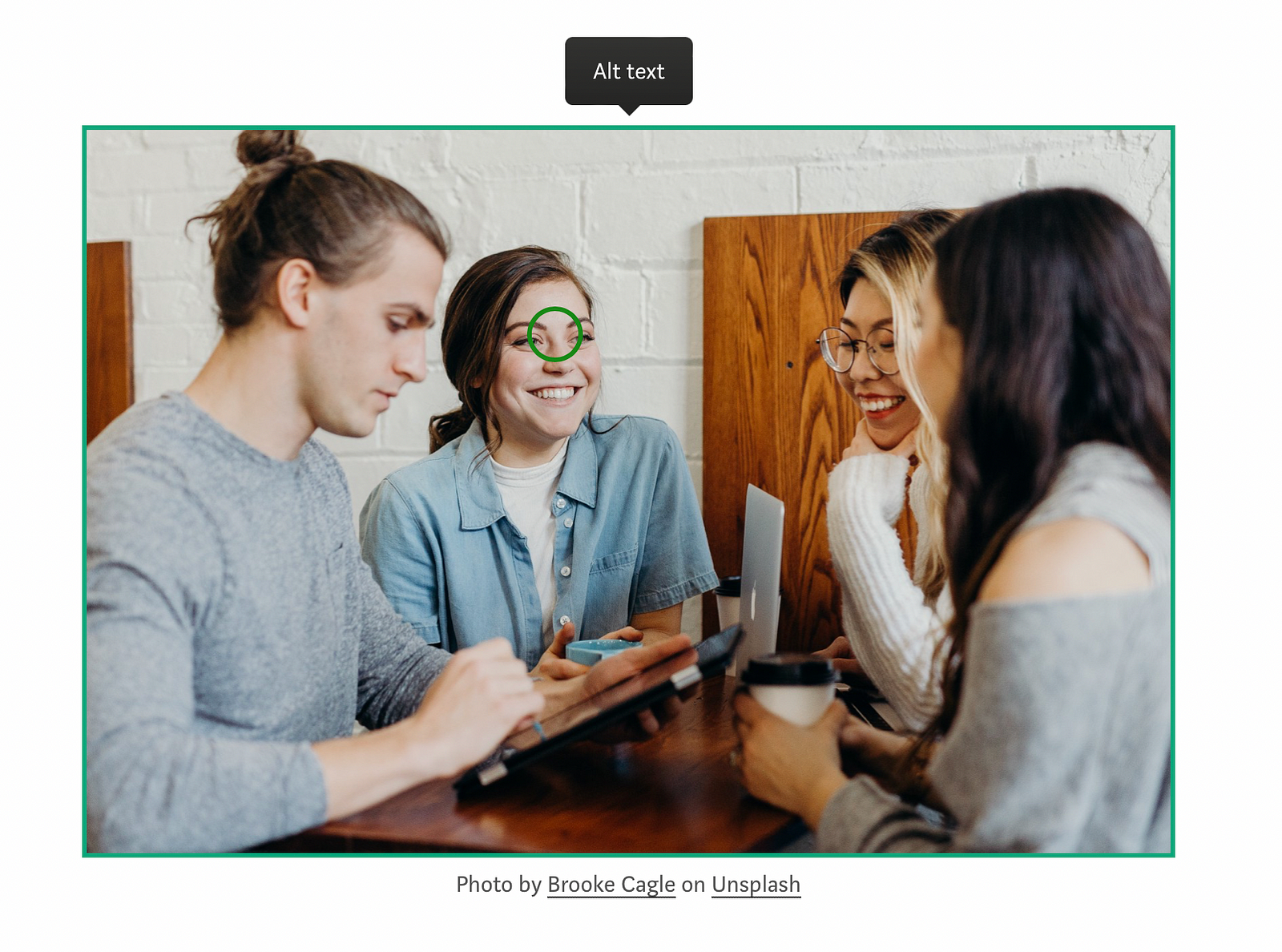
Media Embeds
Medium makes it easy to embed content into your story. You can embed YouTube videos, Instagram images, Tweets, links to other stories, and more. Copy the URL of the content you want to embed, paste it into a new line in the editor, and hit enter. Medium does the rest and makes sure everything looks nice. Like this example of an embedded link:
When embedding content other than links, you can also set captions. Like this example of an embedded Tweet:
I wrote a book! 📔
— Justin Cox is spending time elsewhere (@justincox) May 31, 2022
Over the last year, I’ve been working on a book for writers. I’m super excited to share that Write Now: How to Pursue Your Dream and Start Writing Today is available for purchase!#WritingCommunity #booktwt #AuthorsOfTwitterhttps://t.co/YYyXPpjwb0
You can also add embeds by clicking the + button that forms on a new line and selecting the play button.

Dividers
Want to break up your text without using a section heading? A divider is a great option. Open the new line options (hit the + when starting a new line) and choose the -- button. This generates a separator to add spacing to your story, like the one below.
Draft Links
One of the great things about Medium is you don’t have to write alone. Medium makes it easy to share unpublished drafts with friends. Click the ... button at the top of the writing screen and then select Share to generate a shareable link. Anyone with a Medium account can open this draft link and read your story before it publishes.
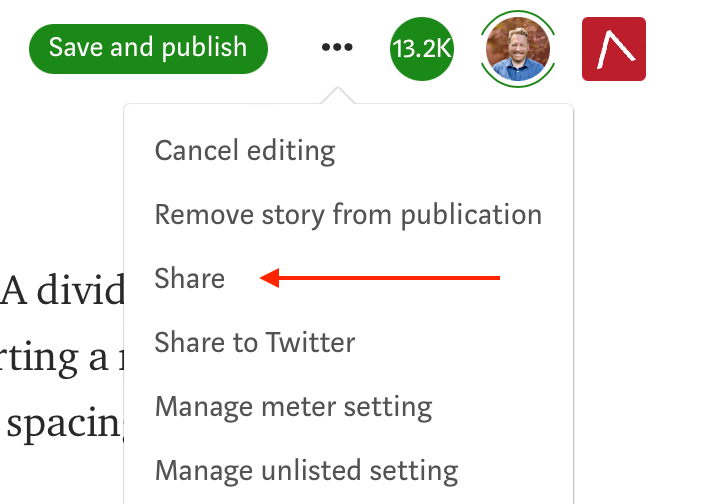
Sharing a draft link is a great way to solicit feedback from friends. When someone views your unpublished draft and leaves a private note, they are acknowledged at the bottom of your story when you hit publish. Writers can turn off attribution if they don’t want their name listed.

TK
In publishing, TK stands for “to come.” Think of it as a placeholder for information not yet ready for publication. When typing TK anywhere in a Medium draft, a yellow margin note appears to signify the missing information or a place you want to return to later. Additionally, when trying to publish a story with a TK, Medium warns you the story may not yet be ready. (Fair warning: when editing an already published story, this warning does not appear…)

Tagging people
Medium provides a simple way to tag other Medium accounts in your story. In the editor, type an @ and the user’s name. Medium creates a list of accounts matching the typed characters. When the story is published, tagged users show in green with a link to their Medium profile. For example, this is what tagging Medium CEO Tony Stubblebine looks like.
While tagging is a powerful tool, use it sparingly. Tagging people who have nothing to do with a story’s content is a form of spam — especially when adding a giant list of tagged accounts at the bottom of a story. However, tagging someone you mention or whose quote you’re using is an excellent means of linking to their content.
SEO Tools
Search engine optimization is vital for writers who want their stories to rank well on search pages. Medium provides tools to set the SEO Title and Description read by search engines and displayed in results.
To make changes to the SEO settings, click the ... button in the editor, select More Settings, and scroll down to SEO Settings. Medium provides helpful information to help you optimize the text.
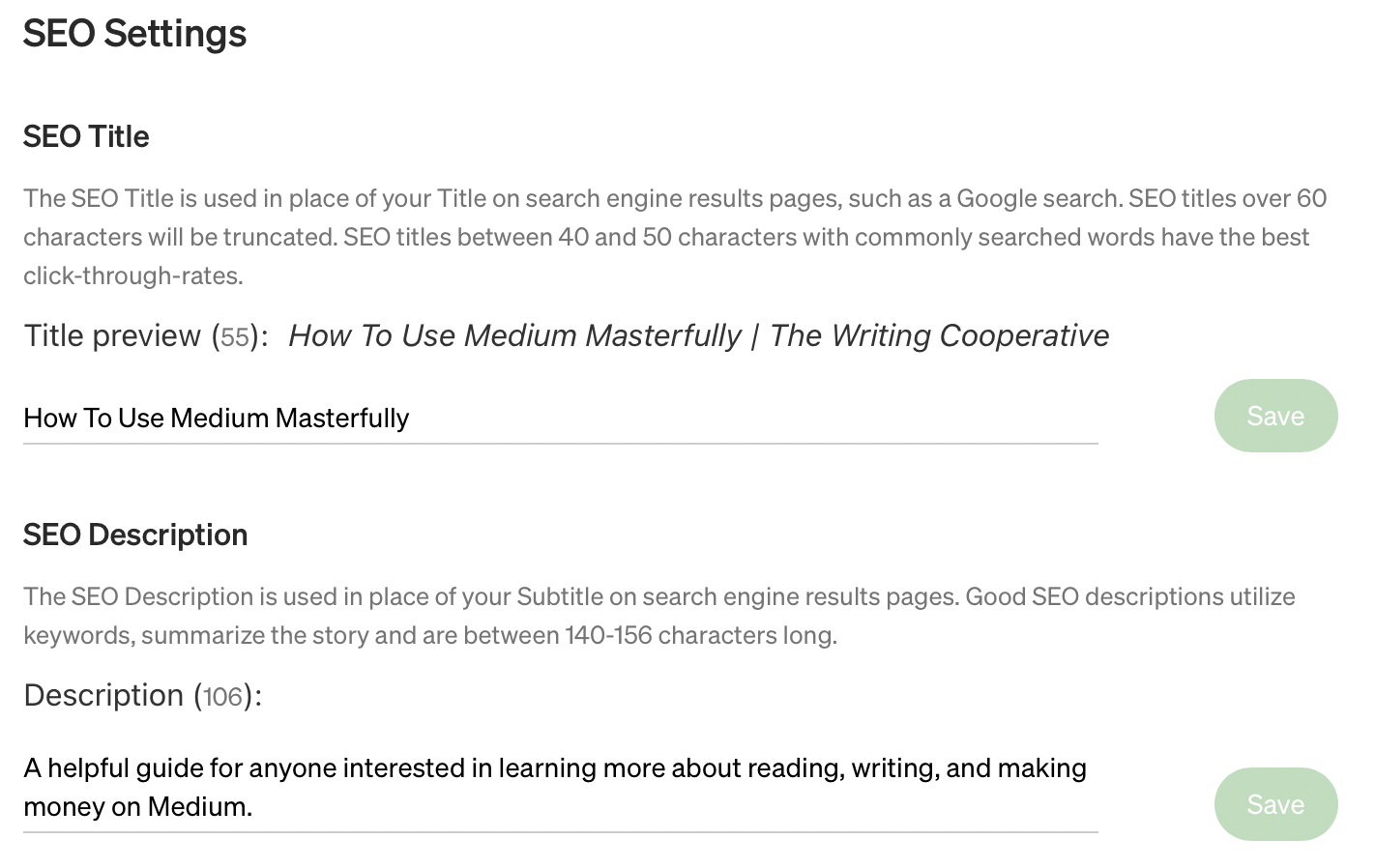
Publish on Medium
After writing and formatting your story, it’s time to publish and share it with the world. While this can often be intimidating, Medium makes it very easy: simply hit the green publish button. Of course, you can enhance your story’s chances of being seen by others by setting tags and submitting to publications.
Select Tags
Medium’s feed only shows the first tag applied to every story. Want to stand out? Don’t select generic tags. I frequently ask writers to change the first tag on a Writing Cooperative story from writing to something more unique. Every story in this publication is about writing, so it shouldn’t appear in the feed.
Consider these questions I posed in a popular issue of This Week In Writing:
So, fellow Medium writers, it’s extremely important to choose the first tag wisely. Instead of picking the most popular tag first, make sure to pick something unique. Does it properly reflect your content? Is it a unique descriptor to capture new audiences?
Another important note, Medium allows you to set five tags. Don’t skimp. Use all of the tag slots available.
You can set the tags after clicking the publish button. Once a story publishes, you can change the tags associated with your story by clicking the ... button in the editor and selecting Change tags.
Submit to Publications
When publishing on Medium, your story is available and promoted to your followers. When a story is considered high-quality by the Medium curators, it is distributed across the platform and to people following a related topic.
When a publication publishes stories, they are also shared with everyone following the publication. The publication’s followers are then added to your followers as people who may see your story. Plus, many publications (like The Writing Cooperative) promote stories on other social networks and newsletters. These are all great opportunities to get your story in front of new people.
When choosing a publication to submit to, writers should consider a few things:
- First, is your story suited to the publication? While The Writing Cooperative, for example, has more than 240,000 followers, it has a narrow focus on writing. Submitting a recipe for chocolate cake will not be accepted.
- Second, does the publication help promote your story? The Writing Cooperative shares all stories on Twitter, Facebook, and LinkedIn, which helps writers expand their reach. Not all publications do the same, so be aware of what benefit you’ll receive from sharing your content.
- Third, will the publication’s audience enhance your following? Publishing in a publication helps extend your story’s reach beyond your following. However, this does not always mean the publication with the larger following is a better fit. Be sure to consider if the publication will provide a boost to your content or if it will mostly go unnoticed. For example, The Writing Cooperative publishes no more than seven stories daily to ensure each one receives ample time in the feed.
Once you’ve determined where to submit, remember it is impossible to submit a story to any publication without first being added as a writer. Each publication has a unique process, and following the directions is essential. Once added as a writer, you can submit a story to a publication by clicking the ... button in the story editor and choosing Add to publication.
Most large publications have clearly defined submission requirements. For example, the Writing Cooperative’s submission requirements are linked in the publication’s menu. Don’t be afraid to submit your story to a publication. You never know what might happen when you do!
Most publications leave private notes on a story to announce it’s been accepted or rejected. Due to volume, many publication editors will not see any response to these private notes. For example, the Writing Cooperative only sees note responses if a previously-rejected submission is again in the submission queue.
Likewise, it is essential to be patient when submitting to a publication. Some publications can take a week or more to respond to submissions. This is normal and often fully outlined in the publication’s submission guidelines.
Content Ownership
Publishing a story or submitting it to a publication may cause ownership concerns. One great thing about Medium is everything you post, whether in a publication or not, is entirely owned by you. By using the service, you give Medium (and a publication if applicable) a license to display your story. You can revoke that license anytime by removing or deleting the story from Medium.
If you want to change your story's content license and ownership settings, you can do that by clicking the ... button in the editor, selecting More settings, and scrolling to Content Licensing.
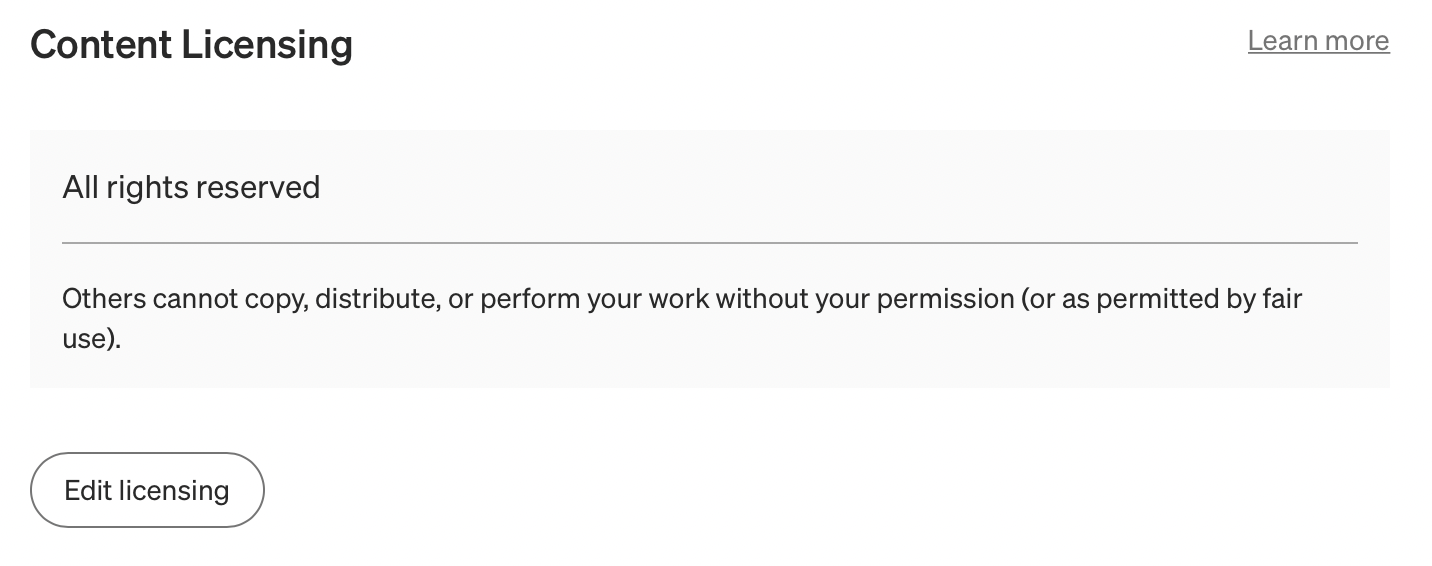
Shortform Content
Anything published with less than 150 words is considered shortform on Medium. These stories automatically generate special formatting that provides the best user experience possible for these brief stories. Additionally, shortform content is governed by additional rules, such as not being distributed by Medium across the platform. Writers interested in writing shortform stories should familiarize themselves with how Medium handles the format.
Track Your Stats
Medium provides basic stats for all published stories. These include:
- Views: The number of people who clicked on your story.
- Reads: The number of people who read the entire story.
- Fans: The number of people who clapped for your story.
Clicking on an individual title within the stats provides more detail on that story. Here, you can see a breakdown of viewers over time, how much the story earned (if it’s metered), where viewers came from, and topics the story’s viewers are interested in (only available once a story reaches around 1,000 views). These additional details can provide insight when marketing your writing.
Get Paid for Writing on Medium
The Medium Partner Program is one of the easiest ways for writers to be compensated for their stories. After joining the program, you can publish metered stories behind Medium’s paywall and begin earning revenue.
When the Partner Program first launched, the only restriction for participation was geographical (locations supported by Stripe). Medium now requires new writers to reach 100 followers and be “active” on the platform before applying for the Partner Program. Getting 100 followers requires writing quality content and engaging with other writers — using all the tips in this guide.
Grow your following
When I originally joined Medium in 2014, it took almost a year to reach 100 followers (thanks to Medium’s new Audience Stats, I could go back to the very beginning and look at my growth over time). While this sounds like a very long time, Medium was a different place back then — there were far fewer daily users, and the popularity of the platform was minimal. I also wasn’t publishing with any kind of regularity. That said, there’s no way to know exactly how long it might take you to reach 100 followers today.
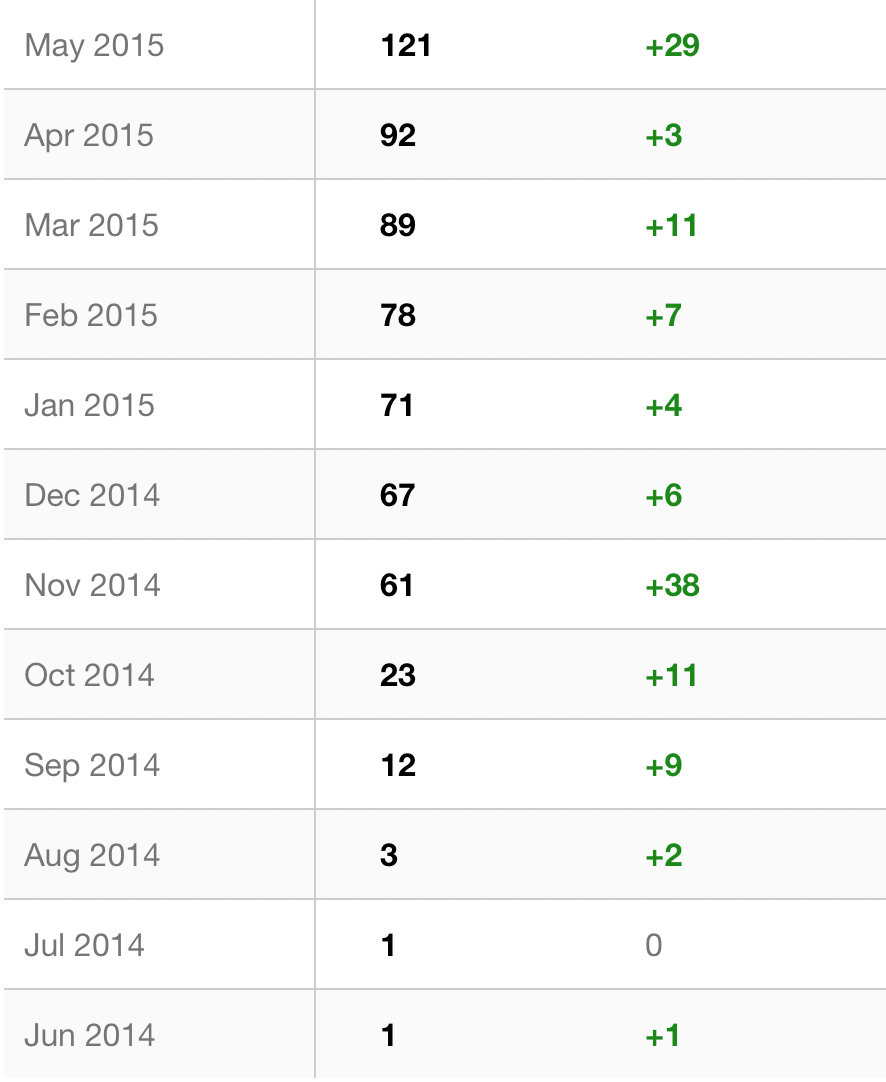
Here are my best suggestions for building your audience and reaching 100 followers:
- Write high-quality content people want to read. Medium’s curators look for unique and well-written stories. If they select your story for distribution in a topic, you typically see a boost in publicity and views.
- Engage with other writers. Read content that you enjoy and then interact with the author. It’s not a guaranteed way to get a follow, but it’s a great way to get noticed by others. Be authentic, don’t go spamming people. No one wants to follow a spammer.
- Publish wisely. Selecting the right publication to submit your story to is also extremely important. Some large publications publish dozens of stories daily, while others, like The Writing Cooperative, only publish a selected handful. Stories in these publications will see much more exposure than those getting lost in a crowd.
- Share and engage outside of Medium, too. Be proud of your work and share it with friends and family who already follow you in other areas. Engage with other writers on and off Medium and join writing communities, like the Writing Community on Twitter. Finally, invest in your professionalism. In time, your following will grow.
Beyond quality writing, there’s no magic bullet — building a following takes time and effort. People who choose to follow you are offering you access to their time. Talk about a big deal! Make sure you create content that people want to engage with.
Once you join the Partner Program, you can do a few new things: publish metered stories and offer affiliate memberships.
Metered stories
When a paying Medium member reads a metered story, a portion of their monthly membership is paid to that story’s writer. Earnings are calculated at the end of each day and paid monthly.
In addition to Medium’s rules that govern what can and cannot be published on the platform, Medium provides Content Guidelines that define what is acceptable for metered stories. Follow the guidelines before submitting a metered story, or you could forfeit potential earnings.
Ok, the rules are great, but I’m sure you really want to know about profitability. When it comes to making the most money possible from your writing, there are a few things to consider.
- Write authentically. Sure, you can try and write for specific topics, but readers will notice and move on if the story is not authentically yours. So, first and foremost, be authentic in the content you publish.
- Publish high-quality content. The best stories on Medium are researched, well-written, highly edited, and unique. This doesn’t mean they are completely free from errors, but all high-quality stories undergo some form of editing. Writers who can knock out 1,000 words on a topic, publish without ever reading through or editing, and fall into the small percentage of profitability are extremely rare (if they exist at all). Take the time to edit your content to be the best version possible.
- Write for your audience. When writing, have an audience in mind. This is not to say general audience content doesn’t work. But when you’re trying to be all things to all people, sometimes authenticity or quality falls behind. If you’re telling a travel story, write for a travel audience. Coding? Write for coders. Your audience exists on Medium, and with proper tagging and publication exposure, you will eventually find them.
- Temper your expectations. While Medium is a great place for writers to earn revenue, it is not where most writers can make a living. Most writers I know use Medium to supplement other income, either from a full-time job, freelance clients, or other projects.
Want to publish metered stories but still let non-paying friends read your work? Every Medium user with a free account can read three metered stories monthly. However, you can share a Friend Link to ensure your friends don’t run into any restrictions (assuming they aren’t paying members who used your affiliate link).
After publishing, scroll to the bottom of your story and click the share button. Select the friend link option from the popup. Regardless of being a paying or free Medium user, anyone with that link can read the story. You are credited for view time if someone reads your story and becomes a paying member within 30 days.
Affiliate memberships
Partner Program members invite people to join Medium with affiliate links. When someone joins using one of these links, you earn compensation for the entirety of that person’s Medium membership. For example, if you sign up for Medium using my affiliate link, I make 50% of your fee for as long as you’re a Medium member.
While laws may vary in other countries, the United States Federal Trade Commission requires affiliate links to be appropriately disclosed. Use affiliate links wisely.
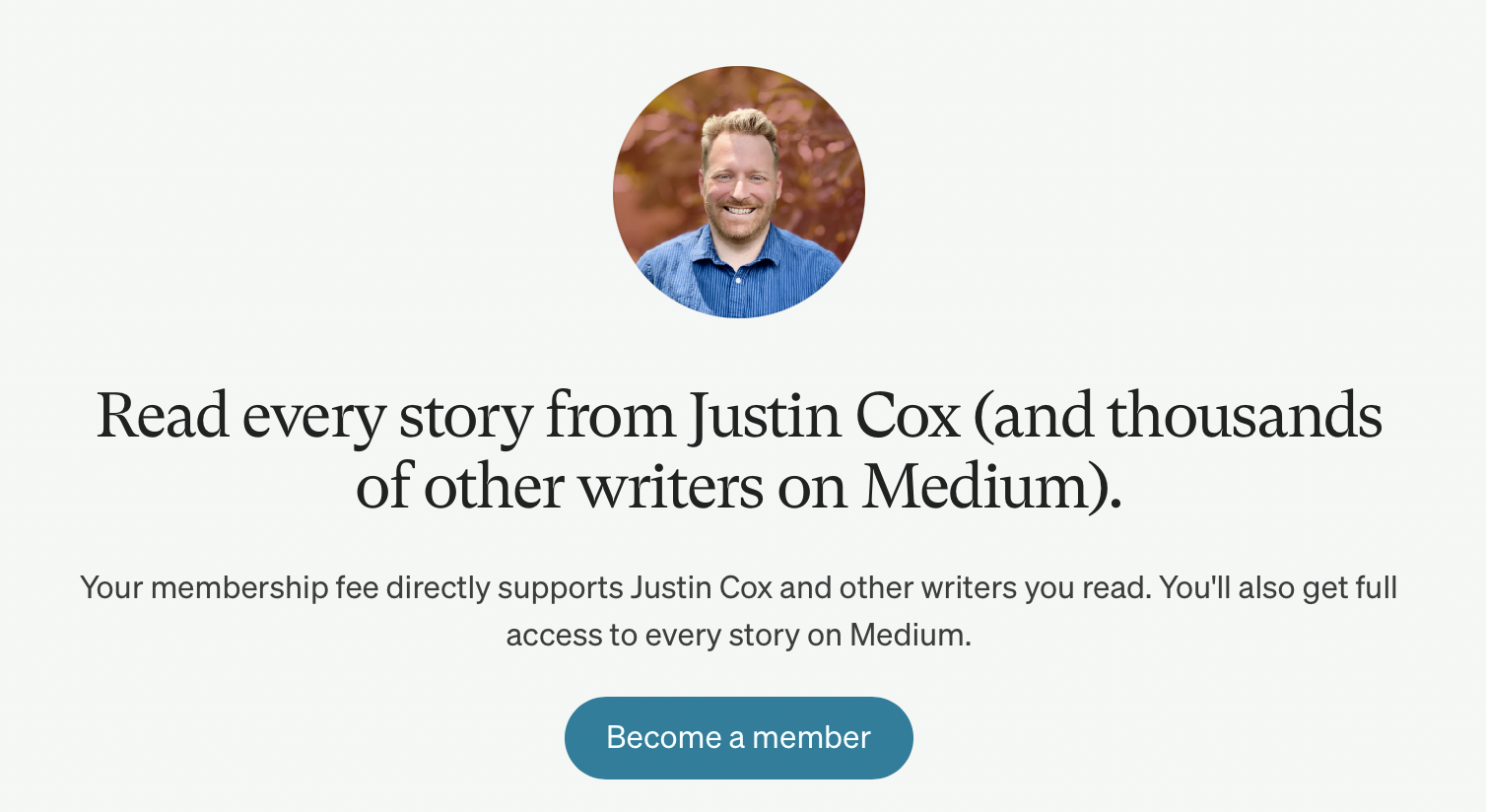
Conclusion
Medium is a fantastic platform filled with excellent writers and readers. It’s a wonderful place to build an audience and share your writing. I hope this guide brought insight and helps you take advantage of everything Medium offers.
Go start following writers, clapping, and sharing stories you enjoy. Enter into conversation with writers using private notes. Write, format, and publish your content! I hope you enjoy your Medium experience as much as I do.
Thank you for reading!


